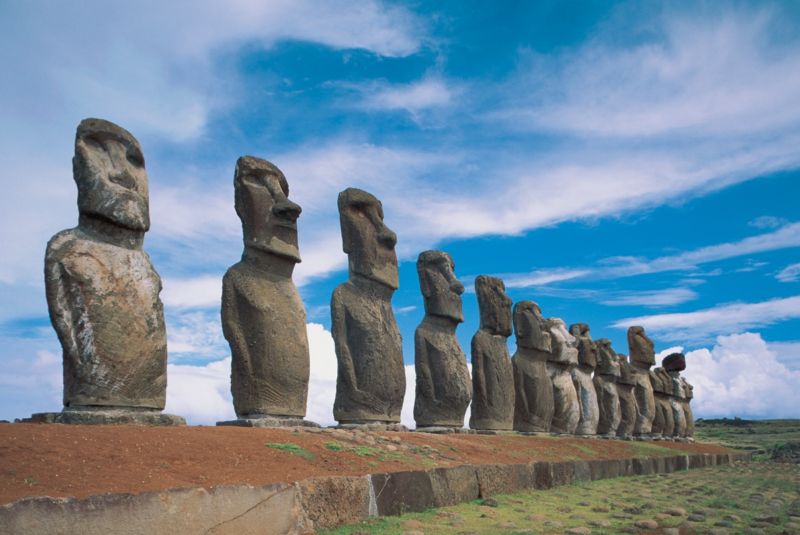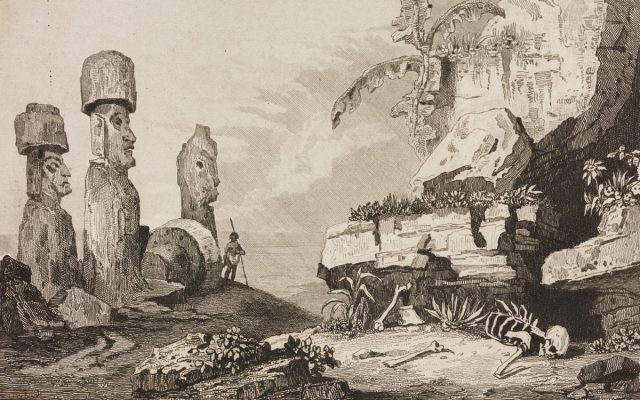
In his bestselling 2005 book Collapse, Jared Diamond offered the societal collapse of Easter Island (aka Rapa Nui), around 1600, as a cautionary tale. Diamond essentially argued that the destruction of the island's ecological environment triggered a downward spiral of internal warfare, population decline, and cannibalism, resulting in an eventual breakdown of social and political structures. It's a narrative that is now being challenged by a team of researchers who have been studying the island's archaeology and cultural history for many years now.
In a new paper published in the Journal of Archaeological Science, the researchers offer intriguing evidence that suggests the people of Rapa Nui continued to thrive well after 1600. The authors suggest this warrants a rethinking of the popular narrative that the island was destitute when Europeans arrived in 1722.
"The degree to which their cultural heritage was passed on—and is still present today through language, arts, and cultural practices—is quite notable and impressive," co-author Robert DiNapoli, a doctoral student in anthropology at the University of Oregon, told Sapiens. "This degree of resilience has been overlooked due to the collapse narrative and deserves recognition."
Easter Island is famous for its giant monumental statues, called moai, built by early inhabitants some 800 years ago. Scholars have puzzled over the moai on Easter Island for decades, pondering their cultural significance, as well as how a Stone Age culture managed to carve and transport statues weighing as much as 92 tons. The moai were typically mounted on platforms called ahu.

Back in 2012, Carl Lipo of Binghamton University and his colleague, Terry Hunt of the University of Arizona, showed that you could transport a 10-foot, 5-ton moai a few hundred yards with just 18 people and three strong ropes by employing a rocking motion. In 2018, Lipo proposed an intriguing hypothesis for how the islanders placed red hats on top of some moai; those can weigh up to 13 tons. He suggested the inhabitants used ropes to roll the hats up a ramp. And as we reported last year, Lipo and his team concluded (based on quantitative spatial modeling) that the islanders likely chose the statues' locations based on the availability of fresh water sources, per their 2019 paper in PLOS One.
For this latest study, Lipo and his colleagues have turned their attention to establishing a better chronology of human occupation of Rapa Nui. While it's generally agreed that people arrived in Eastern Polynesia and on Rapa Nui sometime in the late 12th century or early 13th century, "We don't really know very much about the timing and tempo of events related to ahu construction and moai transport," Lipo told Ars. "We generally know that these kinds of constructions happened sometime prior to Europeans, but exactly how these events played out has been fuzzy."
The team applied a Bayesian model-based method to existing radiocarbon dates collected from prior excavations at 11 different sites with ahu. The model also integrated the order and position of the island's distinctive architecture, as well as ethnohistoric accounts, thereby quantifying the onset of monument construction, the rate at which it occurred, and when it likely ended. This allowed the researchers to test Diamond's "collapse" hypothesis by building a more precise timeline of when construction took place at each of the sites.
"Our results demonstrate a lack of evidence for a pre-contact 'collapse' and instead offer strong support for a new emerging model of resilient communities that continued their long-term traditions despite the impacts of European arrival," the authors wrote. Furthermore, "Methodologically, our model-based approach to testing hypotheses regarding the chronology of collapse can be extended to other case studies around the world where similar debates remain difficult to resolve."
The work has met with some mixed opinions from Lipo's fellow archaeologists. "Their work adds to the growing body of evidence that has accumulated over the last 10 years that the previous narratives of collapse on Easter Island are not correct—and need to be rethought," Seth Quintus, an anthropologist at the University of Hawai'i, Mānoa, told Sapiens. Quintus is not involved with Lipo's study.
However, UCLA archaeologist Jo Anne Van Tilburg—also not involved with the study—expressed skepticism. "The collapse narrative as these authors describe it is a straw man they have set up that does not accurately reflect the actual hypothesis," Van Tilburg told Sapiens. She thinks Diamond's collapse hypothesis is still a viable option, arguing that his hypothesis was not based on a single collapse event but on a series of events that led to the destruction of the social structure, aggravated further by the arrival of European explorers.

Lipo acknowledges that some critics have suggested his team cherry-picked its radiocarbon dating, which he dismisses as "simply baloney and misinformed thinking." According to Lipo, some radiocarbon samples can be biased due to issues with "old carbon": that is, the samples were taken from chunks of burned wood or charcoal, for instance. "Some parts of trees can be far older than others due to the fact that they grew when the tree was just starting," he said, which can skew radiocarbon dating results.
So he and his team filtered their radiocarbon samples to just those they were confident related to human occupation and human-related events, meaning they analyzed a smaller subset of all the available ages—not an unusual strategy. And the results for colonization estimates are about the same as before.
Other critics have insisted that there must be a period of time that predates the earliest radiocarbon age that anyone has yet found. "This is an argument based on the lack of evidence—i.e., that something happened for which we will never have a record," said Lipo. "As scientists, our strategy has been to explain the evidence we find, which means explaining the archaeological record (and the radiocarbon ages) that we have available. Speculating something that is inherently unknowable and invisible is a matter of faith rather than science."
In addition, because of the island's small size, Lipo says that human impact would have been "pretty much instantaneous." So "unless people got to the island and hid in a single cave for centuries, we would have evidence to show their impact," he added.
On the other end of the chronology, Lipo says his team has seen less push back. "Others are starting to demonstrate that ahu construction, moai carving, and other activities continued not only up until European arrival in 1722 but also past that point in time," he said. "The entire notion that all of the activity related to the construction and use of monumental architecture ceased at some point in the late 17th century simply has no empirical basis."

As for Tilburg's "straw man," accusation, Lipo isn't having it. "Calling something a 'straw man' hypothesis is one way of changing one's narrative to say that 'we have been saying that all along,'" he said. "It's a specious statement and entirely misleading." He counter-argues that Diamond's "evidence" for the collapse argument was quite specific: the arrival of people on the island as early as 700 CE, an "ecological paradise" that existed when humans arrived, massive population sizes (up to 30,000), evidence of erosion, overfishing, widespread group-level warfare, and cannibalism.
"Our work has consisted of just examining the archaeological evidence that should be apparent to support his claims," said Lipo. "We have simply a lack of anything remotely like what Diamond has said. Instead, we have learned that his reasoning is based on a deeply flawed misunderstanding of the historical record of the island (particularly the impact of post-European conditions) as well as poor assumptions about human behavior in general."
At the moment, field work is not possible given the ongoing global pandemic. But Lipo and his colleagues plan to continue their studies of Easter Island, testing hypotheses with data generated from the record through additional fieldwork, remote sensing, and artifact analysis. According to Lipo, they will be expanding their analyses to focus more on explaining why the communities on Rapa Nui worked together so consistently to create the island's spectacular architecture.
"Diamond (and others) tend to cast statue construction as just a 'cultural' thing that got out of control," said Lipo. "But we haven't found that answer to be very satisfying. Why Rapa Nui and not elsewhere across the Pacific? Why do it in the first place, and then why keep doing it over and over? Figuring this out is essential if we are really going to solve the 'mystery' of Easter Island."
DOI: Journal of Archaeological Science, 2020. 10.1016/j.jas.2020.105094 (About DOIs).
reader comments
68